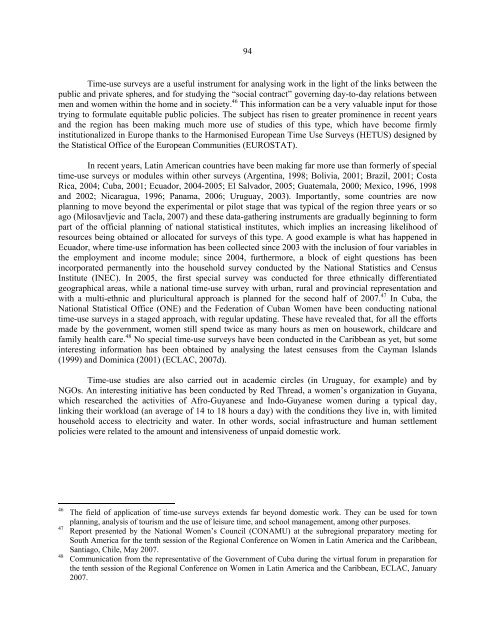Women in Latin America and the Caribbean - Cepal
Women in Latin America and the Caribbean - Cepal
Women in Latin America and the Caribbean - Cepal
Create successful ePaper yourself
Turn your PDF publications into a flip-book with our unique Google optimized e-Paper software.
94<br />
Time-use surveys are a useful <strong>in</strong>strument for analys<strong>in</strong>g work <strong>in</strong> <strong>the</strong> light of <strong>the</strong> l<strong>in</strong>ks between <strong>the</strong><br />
public <strong>and</strong> private spheres, <strong>and</strong> for study<strong>in</strong>g <strong>the</strong> “social contract” govern<strong>in</strong>g day-to-day relations between<br />
men <strong>and</strong> women with<strong>in</strong> <strong>the</strong> home <strong>and</strong> <strong>in</strong> society. 46 This <strong>in</strong>formation can be a very valuable <strong>in</strong>put for those<br />
try<strong>in</strong>g to formulate equitable public policies. The subject has risen to greater prom<strong>in</strong>ence <strong>in</strong> recent years<br />
<strong>and</strong> <strong>the</strong> region has been mak<strong>in</strong>g much more use of studies of this type, which have become firmly<br />
<strong>in</strong>stitutionalized <strong>in</strong> Europe thanks to <strong>the</strong> Harmonised European Time Use Surveys (HETUS) designed by<br />
<strong>the</strong> Statistical Office of <strong>the</strong> European Communities (EUROSTAT).<br />
In recent years, Lat<strong>in</strong> <strong>America</strong>n countries have been mak<strong>in</strong>g far more use than formerly of special<br />
time-use surveys or modules with<strong>in</strong> o<strong>the</strong>r surveys (Argent<strong>in</strong>a, 1998; Bolivia, 2001; Brazil, 2001; Costa<br />
Rica, 2004; Cuba, 2001; Ecuador, 2004-2005; El Salvador, 2005; Guatemala, 2000; Mexico, 1996, 1998<br />
<strong>and</strong> 2002; Nicaragua, 1996; Panama, 2006; Uruguay, 2003). Importantly, some countries are now<br />
plann<strong>in</strong>g to move beyond <strong>the</strong> experimental or pilot stage that was typical of <strong>the</strong> region three years or so<br />
ago (Milosavljevic <strong>and</strong> Tacla, 2007) <strong>and</strong> <strong>the</strong>se data-ga<strong>the</strong>r<strong>in</strong>g <strong>in</strong>struments are gradually beg<strong>in</strong>n<strong>in</strong>g to form<br />
part of <strong>the</strong> official plann<strong>in</strong>g of national statistical <strong>in</strong>stitutes, which implies an <strong>in</strong>creas<strong>in</strong>g likelihood of<br />
resources be<strong>in</strong>g obta<strong>in</strong>ed or allocated for surveys of this type. A good example is what has happened <strong>in</strong><br />
Ecuador, where time-use <strong>in</strong>formation has been collected s<strong>in</strong>ce 2003 with <strong>the</strong> <strong>in</strong>clusion of four variables <strong>in</strong><br />
<strong>the</strong> employment <strong>and</strong> <strong>in</strong>come module; s<strong>in</strong>ce 2004, fur<strong>the</strong>rmore, a block of eight questions has been<br />
<strong>in</strong>corporated permanently <strong>in</strong>to <strong>the</strong> household survey conducted by <strong>the</strong> National Statistics <strong>and</strong> Census<br />
Institute (INEC). In 2005, <strong>the</strong> first special survey was conducted for three ethnically differentiated<br />
geographical areas, while a national time-use survey with urban, rural <strong>and</strong> prov<strong>in</strong>cial representation <strong>and</strong><br />
with a multi-ethnic <strong>and</strong> pluricultural approach is planned for <strong>the</strong> second half of 2007. 47 In Cuba, <strong>the</strong><br />
National Statistical Office (ONE) <strong>and</strong> <strong>the</strong> Federation of Cuban <strong>Women</strong> have been conduct<strong>in</strong>g national<br />
time-use surveys <strong>in</strong> a staged approach, with regular updat<strong>in</strong>g. These have revealed that, for all <strong>the</strong> efforts<br />
made by <strong>the</strong> government, women still spend twice as many hours as men on housework, childcare <strong>and</strong><br />
family health care. 48 No special time-use surveys have been conducted <strong>in</strong> <strong>the</strong> <strong>Caribbean</strong> as yet, but some<br />
<strong>in</strong>terest<strong>in</strong>g <strong>in</strong>formation has been obta<strong>in</strong>ed by analys<strong>in</strong>g <strong>the</strong> latest censuses from <strong>the</strong> Cayman Isl<strong>and</strong>s<br />
(1999) <strong>and</strong> Dom<strong>in</strong>ica (2001) (ECLAC, 2007d).<br />
Time-use studies are also carried out <strong>in</strong> academic circles (<strong>in</strong> Uruguay, for example) <strong>and</strong> by<br />
NGOs. An <strong>in</strong>terest<strong>in</strong>g <strong>in</strong>itiative has been conducted by Red Thread, a women’s organization <strong>in</strong> Guyana,<br />
which researched <strong>the</strong> activities of Afro-Guyanese <strong>and</strong> Indo-Guyanese women dur<strong>in</strong>g a typical day,<br />
l<strong>in</strong>k<strong>in</strong>g <strong>the</strong>ir workload (an average of 14 to 18 hours a day) with <strong>the</strong> conditions <strong>the</strong>y live <strong>in</strong>, with limited<br />
household access to electricity <strong>and</strong> water. In o<strong>the</strong>r words, social <strong>in</strong>frastructure <strong>and</strong> human settlement<br />
policies were related to <strong>the</strong> amount <strong>and</strong> <strong>in</strong>tensiveness of unpaid domestic work.<br />
46<br />
47<br />
48<br />
The field of application of time-use surveys extends far beyond domestic work. They can be used for town<br />
plann<strong>in</strong>g, analysis of tourism <strong>and</strong> <strong>the</strong> use of leisure time, <strong>and</strong> school management, among o<strong>the</strong>r purposes.<br />
Report presented by <strong>the</strong> National <strong>Women</strong>’s Council (CONAMU) at <strong>the</strong> subregional preparatory meet<strong>in</strong>g for<br />
South <strong>America</strong> for <strong>the</strong> tenth session of <strong>the</strong> Regional Conference on <strong>Women</strong> <strong>in</strong> Lat<strong>in</strong> <strong>America</strong> <strong>and</strong> <strong>the</strong> <strong>Caribbean</strong>,<br />
Santiago, Chile, May 2007.<br />
Communication from <strong>the</strong> representative of <strong>the</strong> Government of Cuba dur<strong>in</strong>g <strong>the</strong> virtual forum <strong>in</strong> preparation for<br />
<strong>the</strong> tenth session of <strong>the</strong> Regional Conference on <strong>Women</strong> <strong>in</strong> Lat<strong>in</strong> <strong>America</strong> <strong>and</strong> <strong>the</strong> <strong>Caribbean</strong>, ECLAC, January<br />
2007.











